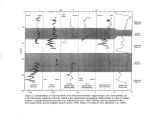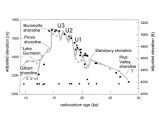| OCR Text |
Show return to Utah juniper dominated woodland with a mixed understory of sagebrush and saltbush indicates drier conditions at ca. 29.6 ka. A major drought from 28 to 26 ka, evidenced by saltbush expansion, apparently resulted in lowered lake levels throughout the northwestern Great Basin. After 24.5 ka effectively moister climate encouraged the spread of Utah juniper woodlands and allowed whitebark pine's intrusion into scattered localities down to 1,380 m, coincident with renewed growth of pluvial Lake Lahontan. Slopes currently dominated by saltbush scrub were characterized by sagebrush steppe and by occasional perennial seeps lush with spike- rush. By 21.5 ka the onset of cooler, drier glacial maximum conditions led to a decline in Utah juniper, disappearance of whitebark pine, and sagebrush steppe and shadscale desert scrub expansions. Warmer, wetter conditions following the glacial maximum led to dramatic increases in sagebrush- dominated communities, and limited re- expansion of whitebark pine as well. By 12.5 ka ( concurrent with the highest stands of pluvial Lake Lahontan [ Benson et al. 1990]) mesic plant communities, reflecting lake effect and orographic forcing of rainfall along the east shore of pluvial Lake Lahontan, contrasted sharply with more xeric plant communities to the west. Warmer, drier conditions during the early Holocene resulted in expansion of saltbush scrub onto the floor of the shrinking pluvial Lake Lahontan and into areas abandoned by sagebrush steppe and Utah juniper woodland. Whitebark pine retreated 1,300 m higher into the Sierra Nevada. At Lake Tahoe severe middle Holocene drought is indicated by submerged stumps, with lake levels at least 6 m and perhaps as much as 18 m below the present sill level. Lake levels may have fallen as much or more at Pyramid Lake. Concurrently, semi- arid woodlands retreated at least 50 m in the Virginia Mountains and at least 150 m in the White Mountains. Late Holocene pollen records from Little Valley ( eastern Tahoe Basin rim) and Diamond Pond ( Harney Basin), together with plant macrofossils from ancient woodrat dens, indicate that juniper- dominated semi- arid woodland reached its late Holocene maximum areal extent during the Neoglacial ( 2 to 4 ka). In south- central Oregon the wettest conditions occurred around 3.6 ka. These records, together with those from Lead Lake ( Carson Sink) and McCoy Flat ( Eagle Lake Basin) indicate contracting semi- arid woodland ( a regional decline in juniper) after ca. 1.9 ka. These pollen records indicate that this drought ended by ca. 1.6 ka. Warmer temperatures and summer- shifted rainfall resulting in greater grass abundance in northern Great Basin sagebrush steppe, reaching its maximum between 1.5 and 1.2 ka, corresponds to dramatic increases in bison remains in archaeological sites of the northern Intermontane West ( northern Great Basin, Snake River Plain and Plateau of eastern Washington). These conditions also favored the sudden northward and downward expansion of pinon into areas that had been previously dominated by juniper. Although both grass and pinon increases seem to reflect a shift toward summer season rainfall, pinon expansion may also reflect response to less harsh winter conditions and longer growing seasons. Numerous lines of evidence point to renewed severe droughts between .5 to .6 ka with pinon retreat, followed by effectively wetter conditions during the Little Ice Age that resulted in re- expansion of juniper ~ .35 ka. Historic contraction of juniper and expansion of pinon in northern and central Nevada may be related to warmer conditions after the Little Ice Age. European introduction of grazing animals and fire supression in the northern Great Basin has led to juniper expansion. Clearly, during the last 150 years the combination of anthropogenic and natural factors have intensified and accelerated Great Basin vegetation community response to climate change. Southern Great Basin. In the mountains of the southern Great Basin and the northern Mojave Desert, woodrat middens document the expansions and contractions of limber pine and white fir reflecting periods of wetter and drier climate during the late Pleistocene. Periods of white fir |

































































































































































